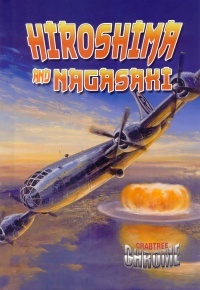| ________________
CM . . . . Volume XX Number 23 . . . . February 14, 2014
excerpt:
Hiroshima and Nagasaki is yet another title in Crabtree's excellent "Chrome" series. This series of high interest titles is designed for middle-years students who are reading at Fontas and Pinnell levels L- M or Reading Recovery/PM Benchmark equivalent levels, 19-20. However, the high quality of the book's writing, structure and detail makes the title appropriate for higher level readers. The story begins with the theory of how and why nuclear weapons could be produced. In the 1930s, nuclear physicists knew they could develop such as weapon, and when the Second World War began in 1939, the Allied powers believed that they must produce a nuclear bomb before Germany's scientists did. In 1942, scientists from Canada, Britain and the United States started working together to build a bomb. The war in Europe ended in May 1945, but the war with Japan continued. After Japan refused to surrender, President Harry Truman made the hard decision to use atomic weapons rather than invading the Japanese homeland and risking the lives of American and Allied soldiers, sailors and airman. Whether the President's decision was morally and practically justifiable is still one of the most contested issues in modern history. Students learn that the immediate death tolls in Hiroshima, bombed August 6, 1945, and Nagasaki, bombed August 9, 1945, were around 67,000. However, the eventual number of deaths from bomb-related injuries and radiation sickness and cancers numbered near 225,000. The cities were rebuilt after the war, but disfigured survivors suffered discrimination because of their looks. As well, people did not want to marry survivors because of the fear of birth defects. Every year on August 6, people commemorate those who died from the atomic bomb at the Peace Memorial Park in Hiroshima. Readers are reminded that tens of thousands of nuclear weapons are in the hands of various world powers. Some governments and peace campaigners advocate for the control and destruction of these terrible weapons but the world remains a dangerous place because of them. Highly Recommended. Ian Stewart teaches at Cecil Rhodes School in Winnipeg, MB.
To comment
on this title or this review, send mail to cm@umanitoba.ca.
Copyright © the Manitoba Library Association. Reproduction for personal
use is permitted only if this copyright notice is maintained. Any
other reproduction is prohibited without permission.
NEXT REVIEW |
TABLE OF CONTENTS FOR THIS ISSUE
- February 14, 2014.
AUTHORS |
TITLES |
MEDIA REVIEWS |
PROFILES |
BACK ISSUES |
SEARCH |
CMARCHIVE |
HOME |
